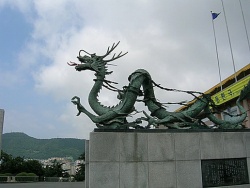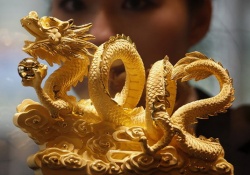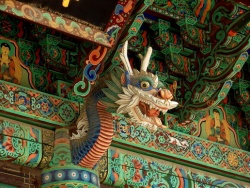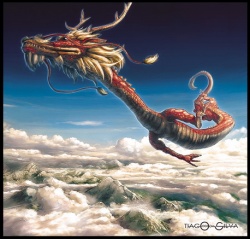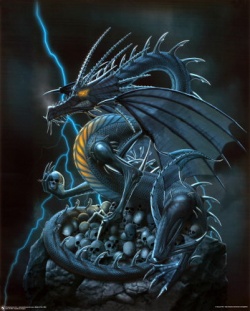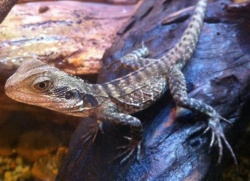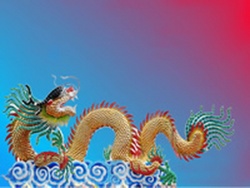Difference between revisions of "Nine Dragon Baguazhang"
| Line 7: | Line 7: | ||
[[File:Picture1 big.jpg|thumb|250px|]] | [[File:Picture1 big.jpg|thumb|250px|]] | ||
[[File:Ound ava.jpg|thumb|250px|]] | [[File:Ound ava.jpg|thumb|250px|]] | ||
| − | Some {{Wiki|individuals}} [[suffer]] from the misconception that the [[Chinese Dragon]] is a [[symbol]] of [[evil]]. This erroneous [[belief]] stems from the [[mythology]] of the {{Wiki|western}} [[world]] where the [[dragon]] was [[thought]] to abduct maidens, wreak havoc on the populace, steal {{Wiki|gold}} and destroy villages. In the mediaeval context the {{Wiki|Western}} [[dragon]] was often the [[symbol]] of Satan [[incarnate]]. This is not so in the [[dragons]] of the {{Wiki|orient}}. In fact it is just the {{Wiki|opposite}}. The [[dragons]] of [[China]] and [[Japan]] are almost exclusively {{Wiki|benevolent}} [[mythological]] creatures. In fact they are so different in [[nature]] from {{Wiki|Western}} [[Dragons]] that it may be more reasonable to consider them as dissimilar creatures, rather than as the same creature interpreted differently. | + | |
| + | |||
| + | |||
| + | |||
| + | <poem> | ||
| + | Some {{Wiki|individuals}} [[suffer]] from the {{Wiki|misconception}} that the [[Chinese Dragon]] is a [[symbol]] of [[evil]]. This erroneous [[belief]] stems from the [[mythology]] of the {{Wiki|western}} [[world]] where the [[dragon]] was [[thought]] to abduct maidens, wreak havoc on the populace, steal {{Wiki|gold}} and destroy villages. In the mediaeval context the {{Wiki|Western}} [[dragon]] was often the [[symbol]] of [[Satan]] [[incarnate]]. This is not so in the [[dragons]] of the {{Wiki|orient}}. In fact it is just the {{Wiki|opposite}}. The [[dragons]] of [[China]] and [[Japan]] are almost exclusively {{Wiki|benevolent}} [[mythological]] creatures. In fact they are so different in [[nature]] from {{Wiki|Western}} [[Dragons]] that it may be more reasonable to consider them as dissimilar creatures, rather than as the same creature interpreted differently. | ||
The {{Wiki|Chinese}} call the [[dragon]] '[[lung]]' (long) because it is [[deaf]]. It is the largest of scaly [[animals]], and it has the following nine {{Wiki|characteristics}}. Its {{Wiki|head}} is like a {{Wiki|camels}}, its horns like a deer's, its [[eyes]] like a hare's, its {{Wiki|ears}} like a bull's, its neck like an iguana's, its belly like a frog's, its scales like those of a carp, its paws like a tiger's, and its claws like an eagle's. It has nine times nine scales, it {{Wiki|being}} the extreme of a [[lucky]] number. | The {{Wiki|Chinese}} call the [[dragon]] '[[lung]]' (long) because it is [[deaf]]. It is the largest of scaly [[animals]], and it has the following nine {{Wiki|characteristics}}. Its {{Wiki|head}} is like a {{Wiki|camels}}, its horns like a deer's, its [[eyes]] like a hare's, its {{Wiki|ears}} like a bull's, its neck like an iguana's, its belly like a frog's, its scales like those of a carp, its paws like a tiger's, and its claws like an eagle's. It has nine times nine scales, it {{Wiki|being}} the extreme of a [[lucky]] number. | ||
| − | On each side of the [[dragons]] {{Wiki|mouth}} are whiskers, under its chin or floating just out of reach is a bright {{Wiki|pearl}}, on the top of its {{Wiki|head}} the 'poh shan' or foot rule, without which it cannot ascend to [[heaven]]. The scales of the dragon's {{Wiki|throat}} are reversed. When exhaling its [[breath]] changes into clouds from which can come either [[fire]] or [[rain]]. The [[dragon]] is fond of eating the flesh of sparrows and swallows, it is afraid of the mineral {{Wiki|iron}} and swords made of {{Wiki|iron}}. The [[dragon]] shuns [[contact]] with the centipede and {{Wiki|silk}} dyed of five colors. | + | On each side of the [[dragons]] {{Wiki|mouth}} are whiskers, under its [[chin]] or floating just out of reach is a bright {{Wiki|pearl}}, on the top of its {{Wiki|head}} the 'poh shan' or foot {{Wiki|rule}}, without which it cannot ascend to [[heaven]]. The scales of the [[dragon's]] {{Wiki|throat}} are reversed. When exhaling its [[breath]] changes into clouds from which can come either [[fire]] or [[rain]]. The [[dragon]] is fond of eating the flesh of sparrows and swallows, it is afraid of the mineral {{Wiki|iron}} and swords made of {{Wiki|iron}}. The [[dragon]] shuns [[contact]] with the centipede and {{Wiki|silk}} dyed of [[five colors]]. |
| − | Dr. S. Wells Williams says of the [[Chinese dragon]]: | + | Dr. S. Wells [[Williams]] says of the [[Chinese dragon]]: |
| − | 'Its {{Wiki|voice}} is like the jingling of {{Wiki|copper}} pans.' It is possible that there may be a connection between the dragon's [[love]] of eating swallows or sparrows and the [[habits]] of crocodiles, who lie basking with jaws agape and allow birds to move in and out of their mouths, picking their teeth. The dragon's {{Wiki|fear}} of {{Wiki|iron}} is as well documented as his [[love]] of swallows, and it is said that he can be killed only by a single needle of {{Wiki|iron}} which conjures up a [[mental]] picture of the conquering hero's lance. | + | 'Its {{Wiki|voice}} is like the jingling of {{Wiki|copper}} pans.' It is possible that there may be a [[connection]] between the [[dragon's]] [[love]] of eating swallows or sparrows and the [[habits]] of crocodiles, who lie basking with jaws agape and allow birds to move in and out of their mouths, picking their {{Wiki|teeth}}. The [[dragon's]] {{Wiki|fear}} of {{Wiki|iron}} is as well documented as his [[love]] of swallows, and it is said that he can be killed only by a single needle of {{Wiki|iron}} which conjures up a [[mental]] picture of the conquering hero's lance. |
| − | [[Dragons]] were believed to lay eggs, and the young [[dragon]] to remain in its egg for 3,000 years - 1,000 in the [[water]], 1,000 in the mountains, and 1,000 in the land of men. These eggs may occasionally have been {{Wiki|snakes}}' eggs, but more often they were [[beautiful]] stones of five colors, which gave off [[water]], or at least {{Wiki|moisture}}, when [[rain]] was about. It was unwise to be in possession of one at the moment of [[birth]] for it would hatch in the [[form]] of a tiny worm or {{Wiki|snake}} and grow within minutes into a full-sized [[dragon]] which would whirl up to the sky in a thunderstorm, tearing its way out through the roof. | + | [[Dragons]] were believed to lay eggs, and the young [[dragon]] to remain in its egg for 3,000 years - 1,000 in the [[water]], 1,000 in the [[mountains]], and 1,000 in the land of men. These eggs may occasionally have been {{Wiki|snakes}}' eggs, but more often they were [[beautiful]] stones of [[five colors]], which gave off [[water]], or at least {{Wiki|moisture}}, when [[rain]] was about. It was unwise to be in possession of one at the [[moment]] of [[birth]] for it would hatch in the [[form]] of a tiny worm or {{Wiki|snake}} and grow within minutes into a full-sized [[dragon]] which would whirl up to the sky in a thunderstorm, tearing its way out through the roof. |
| − | Whirlwinds and waterspouts are thus explained as a young [[dragon]] ascending to [[heaven]]. [[Empty]] [[dragon]] eggs are said to be preserved in some [[monasteries]], each taking the [[form]] of an exceptionally [[beautiful]] stone with a small hole in it, and one [[monastery]] preserved a [[dragon]] egg which had [[died]], that is, stopped giving off {{Wiki|moisture}}. The foetus was said to be [[visible]] inside. [[Dragon]] eggs, incidentally, should not be confused with '{{Wiki|thunder}} stones' which are prehistoric stone [[weapons]] once considered by the {{Wiki|Chinese}}, and by the [[Japanese]], to be thunderbolts. | + | Whirlwinds and waterspouts are thus explained as a young [[dragon]] ascending to [[heaven]]. [[Empty]] [[dragon]] eggs are said to be preserved in some [[monasteries]], each taking the [[form]] of an exceptionally [[beautiful]] stone with a small hole in it, and one [[monastery]] preserved a [[dragon]] egg which had [[died]], that is, stopped giving off {{Wiki|moisture}}. The {{Wiki|foetus}} was said to be [[visible]] inside. [[Dragon]] eggs, incidentally, should not be confused with '{{Wiki|thunder}} stones' which are prehistoric stone [[weapons]] once considered by the {{Wiki|Chinese}}, and by the [[Japanese]], to be thunderbolts. |
| − | The Eastern [[dragons]] were assuredly weather-lords. Floods were [[caused]] by [[dragons]] fighting in the [[water]] and storms by [[dragons]] fighting in the [[air]]. {{Wiki|Lightning}} was [[heavenly]] [[fire]] sent to stop the [[dragon]] fights, for [[dragons]] {{Wiki|fear}} [[fire]]. This last might be considered odd, in [[view]] of the dragon's own fiery [[breath]], but the {{Wiki|Chinese}} writer Wang Fu said: '[[Dragon]] [[fire]] and [[human]] [[fire]] are {{Wiki|opposite}}. If [[dragon]] [[fire]] comes into [[contact]] with {{Wiki|wetness}} it flames, and if it meets [[water]] it burns. If one drives it away by means of [[fire]], it stops burning and its flames are [[extinguished]].' | + | The Eastern [[dragons]] were assuredly weather-lords. {{Wiki|Floods}} were [[caused]] by [[dragons]] fighting in the [[water]] and storms by [[dragons]] fighting in the [[air]]. {{Wiki|Lightning}} was [[heavenly]] [[fire]] sent to stop the [[dragon]] fights, for [[dragons]] {{Wiki|fear}} [[fire]]. This last might be considered odd, in [[view]] of the [[dragon's]] [[own]] fiery [[breath]], but the {{Wiki|Chinese}} writer Wang [[Fu]] said: '[[Dragon]] [[fire]] and [[human]] [[fire]] are {{Wiki|opposite}}. If [[dragon]] [[fire]] comes into [[contact]] with {{Wiki|wetness}} it flames, and if it meets [[water]] it burns. If one drives it away by means of [[fire]], it stops burning and its flames are [[extinguished]].' |
==={{Wiki|Legends}} of the [[Dragon]]=== | ==={{Wiki|Legends}} of the [[Dragon]]=== | ||
| − | The myriad {{Wiki|legends}} of the [[Chinese Dragon]] permeate {{Wiki|ancient}} {{Wiki|Chinese}} {{Wiki|civilization}} and shaped their {{Wiki|culture}} even today. Its [[benevolence]] {{Wiki|signifies}} greatness, [[goodness]] and [[blessings]]. Instead of {{Wiki|being}} feared and hated the [[Chinese dragons]] are highly respected creatures of good [[fortune]] that bring [[ultimate]] abundance, {{Wiki|prosperity}} and good [[fortune]]. {{Wiki|Chinese}} [[mythology]] says [[dragons]] control the [[rain]], [[rivers]], lakes, and seas. Many {{Wiki|Chinese}} cities have [[pagodas]] where [[people]] used to burn [[incense]] to ask the [[dragons]] to favor their crops or change the weather. [[Dragons]] are referred to as the [[divine]] [[mythical]] creature. | + | The {{Wiki|myriad}} {{Wiki|legends}} of the [[Chinese Dragon]] permeate {{Wiki|ancient}} {{Wiki|Chinese}} {{Wiki|civilization}} and shaped their {{Wiki|culture}} even today. Its [[benevolence]] {{Wiki|signifies}} greatness, [[goodness]] and [[blessings]]. Instead of {{Wiki|being}} feared and hated the [[Chinese dragons]] are highly respected creatures of good [[fortune]] that bring [[ultimate]] abundance, {{Wiki|prosperity}} and good [[fortune]]. {{Wiki|Chinese}} [[mythology]] says [[dragons]] control the [[rain]], [[rivers]], lakes, and seas. Many {{Wiki|Chinese}} cities have [[pagodas]] where [[people]] used to burn [[incense]] to ask the [[dragons]] to favor their crops or change the weather. [[Dragons]] are referred to as the [[divine]] [[mythical]] creature. |
As an [[animal]] possessed of [[magical]] {{Wiki|abilities}} the [[Chinese dragon]] is able to shrink to the size of a {{Wiki|silk}} worm; and then swell up to fill the entire [[space]] between [[heaven]] and [[earth]]. It can make itself [[visible]] or {{Wiki|invisible}}, as it so chooses. It can take on [[human]] [[form]] or that of another [[animal]] to carry out some secret [[mission]]. | As an [[animal]] possessed of [[magical]] {{Wiki|abilities}} the [[Chinese dragon]] is able to shrink to the size of a {{Wiki|silk}} worm; and then swell up to fill the entire [[space]] between [[heaven]] and [[earth]]. It can make itself [[visible]] or {{Wiki|invisible}}, as it so chooses. It can take on [[human]] [[form]] or that of another [[animal]] to carry out some secret [[mission]]. | ||
| − | Everything connected with Eastern [[Dragons]] is blessed. The Year of the [[Dragon]] that takes place ever twelve years is [[lucky]]. Present-day {{Wiki|Oriental}} [[astrologers]] claim that children born during [[Dragon]] Years enjoy health, [[wealth]], and long [[life]]. (1964 and 1976 were [[Dragon]] Years.) | + | Everything connected with Eastern [[Dragons]] is blessed. The Year of the [[Dragon]] that takes place ever twelve years is [[lucky]]. Present-day {{Wiki|Oriental}} [[astrologers]] claim that children born during [[Dragon]] Years enjoy [[health]], [[wealth]], and long [[life]]. (1964 and 1976 were [[Dragon]] Years.) |
| − | [[Dragons]] are so [[wise]] that they have been {{Wiki|royal}} advisors. A thirteenth-century Cambodian [[king]] spent his nights in a golden tower, where he consulted with the {{Wiki|real}} [[ruler]] of the land a nine-headed [[dragon]]. Eastern [[Dragons]] are vain, even though they are [[wise]]. They are insulted when a [[ruler]] doesn't follow their advice, or when [[people]] don't {{Wiki|honor}} their importance. Then, by thrashing about, [[dragons]] either stop making [[rain]] and [[cause]] [[water]] shortages, or they breathe black clouds that bring storms and floods. | + | [[Dragons]] are so [[wise]] that they have been {{Wiki|royal}} advisors. A thirteenth-century [[Cambodian]] [[king]] spent his nights in a golden tower, where he consulted with the {{Wiki|real}} [[ruler]] of the land a nine-headed [[dragon]]. Eastern [[Dragons]] are vain, even though they are [[wise]]. They are insulted when a [[ruler]] doesn't follow their advice, or when [[people]] don't {{Wiki|honor}} their importance. Then, by thrashing about, [[dragons]] either stop making [[rain]] and [[cause]] [[water]] shortages, or they [[breathe]] black clouds that bring storms and floods. |
==Types of [[Dragons]]== | ==Types of [[Dragons]]== | ||
| Line 41: | Line 46: | ||
====[[Spiritual]] [[Dragon]]==== | ====[[Spiritual]] [[Dragon]]==== | ||
| − | The [[spiritual]] [[dragons]] (shen-long) were the weather makers. These giants floated across the sky and due to their blue {{Wiki|color}} that changed constantly were difficult to see clearly. Shen-long governed the [[wind]], clouds and [[rain]] on which all agrarian [[life]] depended. {{Wiki|Chinese}} [[people]] took great care to avoid offending them for if they grew [[angry]] or felt neglected, the result was bad weather, drought of flood. | + | The [[spiritual]] [[dragons]] (shen-long) were the weather makers. These giants floated across the sky and due to their blue {{Wiki|color}} that changed constantly were difficult to see clearly. [[Shen-long]] governed the [[wind]], clouds and [[rain]] on which all agrarian [[life]] depended. {{Wiki|Chinese}} [[people]] took great [[care]] to avoid offending them for if they grew [[angry]] or felt neglected, the result was bad weather, drought of flood. |
====[[Earth]] [[Dragon]]==== | ====[[Earth]] [[Dragon]]==== | ||
| − | [[Dragons]] that ruled the [[rivers]], springs and lakes were called [[Earth]] [[dragons]] (di-long). They hide in the depths of deep watercourses in grand {{Wiki|palaces}}. Many {{Wiki|Chinese}} fairy tales spin yarns of men and women taken into these submarine castles to be granted special favors or gifts. Some of the di-long even mated with women to produce half-human [[dragon]] children. | + | [[Dragons]] that ruled the [[rivers]], springs and lakes were called [[Earth]] [[dragons]] (di-long). They hide in the depths of deep watercourses in grand {{Wiki|palaces}}. Many {{Wiki|Chinese}} {{Wiki|fairy tales}} spin yarns of men and women taken into these submarine castles to be granted special favors or gifts. Some of the di-long even mated with women to produce half-human [[dragon]] children. |
====[[Treasure]] [[Dragon]]==== | ====[[Treasure]] [[Dragon]]==== | ||
| − | Believed to [[live]] in [[caves]] deep in the [[earth]] the (fu-can-long) or [[treasure]] [[dragon]] had charge of all the [[precious]] [[jewels]] and metals buried in the [[earth]]. Each of these [[dragons]] had a [[magical]] {{Wiki|pearl}} that was reputed to multiply if it was touched. This {{Wiki|pearl}} was as [[symbol]] of the most valuable [[treasure]], [[wisdom]]. | + | Believed to [[live]] in [[caves]] deep in the [[earth]] the (fu-can-long) or [[treasure]] [[dragon]] had charge of all the [[precious]] [[jewels]] and metals [[Wikipedia:burial|buried]] in the [[earth]]. Each of these [[dragons]] had a [[magical]] {{Wiki|pearl}} that was reputed to multiply if it was touched. This {{Wiki|pearl}} was as [[symbol]] of the most valuable [[treasure]], [[wisdom]]. |
| Line 56: | Line 61: | ||
==The [[Dragon]] {{Wiki|Pearl}}== | ==The [[Dragon]] {{Wiki|Pearl}}== | ||
| − | The luminous ball or {{Wiki|pearl}} often depicted under the dragon's chin or seen to be spinning in the [[air]], pursued by one or two [[dragons]] is [[thought]] to be a [[symbolic]] [[representation]] of the '[[sacred]] {{Wiki|pearl}}' of [[wisdom]] or yang [[energy]]. {{Wiki|Pearl}} [[symbolism]], like {{Wiki|lunar}} [[symbolism]] arises from {{Wiki|Daoist}} [[roots]] and the connections, are extremely complex. This {{Wiki|pearl}} can be said to stand most often for '[[truth]]' and '[[life]]' - perhaps even everlasting [[life]] which is made available to those who {{Wiki|perceive}} the [[truth]] and attain [[enlightenment]]. | + | The {{Wiki|luminous}} ball or {{Wiki|pearl}} often depicted under the [[dragon's]] [[chin]] or seen to be spinning in the [[air]], pursued by one or two [[dragons]] is [[thought]] to be a [[symbolic]] [[representation]] of the '[[sacred]] {{Wiki|pearl}}' of [[wisdom]] or [[yang]] [[energy]]. {{Wiki|Pearl}} [[symbolism]], like {{Wiki|lunar}} [[symbolism]] arises from {{Wiki|Daoist}} [[roots]] and the connections, are extremely complex. This {{Wiki|pearl}} can be said to stand most often for '[[truth]]' and '[[life]]' - perhaps even everlasting [[life]] which is made available to those who {{Wiki|perceive}} the [[truth]] and attain [[enlightenment]]. |
| − | The dragon's {{Wiki|pearl}} can also be [[thought]] of as a [[symbol]] for [[universal]] Qi the progenitor of all [[energy]] and creation. The [[dragons]] seem to be depicted in attitudes of pursuit. He is seen to be reaching out eagerly to clutch at the elusive [[object]], {{Wiki|mouth}} open in anticipation and [[eyes]] bulging with anticipation of achieving the prize afforded by clutching the {{Wiki|pearl}}. | + | The [[dragon's]] {{Wiki|pearl}} can also be [[thought]] of as a [[symbol]] for [[universal]] Qi the progenitor of all [[energy]] and creation. The [[dragons]] seem to be depicted in attitudes of pursuit. He is seen to be reaching out eagerly to clutch at the elusive [[object]], {{Wiki|mouth}} open in anticipation and [[eyes]] bulging with anticipation of achieving the prize afforded by clutching the {{Wiki|pearl}}. |
| − | In connection with the [[dragon]] the {{Wiki|pearl}} has been called the {{Wiki|image}} of {{Wiki|thunder}}, of the [[moon]], of the {{Wiki|sun}}, of the egg emblem of the dual [[influences]] of [[nature]], and the '{{Wiki|pearl}} of potentiality'. The {{Wiki|pearl}} is most often depicted as a spiral or a {{Wiki|globe}}. In some paintings it is sometimes red, sometimes {{Wiki|gold}}, sometimes the bluish white of a true {{Wiki|pearl}}. The {{Wiki|pearl}} is often accompanied by little jagged flashes that seem to spark out from it, like flames; and it almost always has an appendage in the [[form]] of a small undulating sprout, not unlike the first young shoot from a bean. | + | In [[connection]] with the [[dragon]] the {{Wiki|pearl}} has been called the {{Wiki|image}} of {{Wiki|thunder}}, of the [[moon]], of the {{Wiki|sun}}, of the egg {{Wiki|emblem}} of the dual [[influences]] of [[nature]], and the '{{Wiki|pearl}} of potentiality'. The {{Wiki|pearl}} is most often depicted as a spiral or a {{Wiki|globe}}. In some paintings it is sometimes [[red]], sometimes {{Wiki|gold}}, sometimes the bluish white of a true {{Wiki|pearl}}. The {{Wiki|pearl}} is often accompanied by little jagged flashes that seem to spark out from it, like flames; and it almost always has an appendage in the [[form]] of a small undulating sprout, not unlike the first young shoot from a bean. |
| − | In {{Wiki|Daoist}} [[Wikipedia:concept|concepts]] the [[moon]], pearls, [[dragons]] and serpents are inextricably linked. Like the {{Wiki|snake}} that is [[reborn]] when it sheds its {{Wiki|skin}}, the [[moon]] is [[reborn]] each month, and both are [[symbols]] of [[immortality]]. Like the [[dragon]], the [[moon]] is always associated with [[water]]; its undeniable [[power]] over the tides is believed to extend to all liquids on [[earth]]. The [[dragons]] that lived in the sea were said to be inordinately fond of pearls and collected them and watched over them in great submarine {{Wiki|palaces}}. | + | In {{Wiki|Daoist}} [[Wikipedia:concept|concepts]] the [[moon]], {{Wiki|pearls}}, [[dragons]] and serpents are inextricably linked. Like the {{Wiki|snake}} that is [[reborn]] when it sheds its {{Wiki|skin}}, the [[moon]] is [[reborn]] each month, and both are [[symbols]] of [[immortality]]. Like the [[dragon]], the [[moon]] is always associated with [[water]]; its undeniable [[power]] over the tides is believed to extend to all liquids on [[earth]]. The [[dragons]] that lived in the sea were said to be inordinately fond of {{Wiki|pearls}} and collected them and watched over them in great submarine {{Wiki|palaces}}. |
| − | ==The Jiulong Baguazhang [[Dragons]]== | + | ==The Jiulong [[Baguazhang]] [[Dragons]]== |
| − | The first Gua of the [[Yijing]], Qian ([[heaven]]) is associated with the azure [[dragon]] of the sky. As the Li family developed the Baguazhang of Li, Ching-Yuen for their own use as {{Wiki|martial art}} [[masters]] the [[dragon]] became to them a [[symbol]] of each of the Gua of the [[Yijing]]. | + | The first Gua of the [[Yijing]], [[Qian]] ([[heaven]]) is associated with the azure [[dragon]] of the sky. As the Li [[family]] developed the [[Baguazhang]] of Li, Ching-Yuen for their [[own]] use as {{Wiki|martial art}} [[masters]] the [[dragon]] became to them a [[symbol]] of each of the Gua of the [[Yijing]]. |
This [[symbolism]] of a [[dragon]] representing the eight Gua of was most likely inspired by the "Nine [[Dragon]] [[Spirit]] Screen" that stands on the shore of the {{Wiki|North}} Lake at {{Wiki|Beijing}}. This screen is of brick and gilded stone depicting nine coiling writhing [[dragons]]. | This [[symbolism]] of a [[dragon]] representing the eight Gua of was most likely inspired by the "Nine [[Dragon]] [[Spirit]] Screen" that stands on the shore of the {{Wiki|North}} Lake at {{Wiki|Beijing}}. This screen is of brick and gilded stone depicting nine coiling writhing [[dragons]]. | ||
| Line 73: | Line 78: | ||
Shifu Li said that in [[meditation]], [[dreams]] and during practice the nine [[dragons]] will visit those who are ready to receive their [[knowledge]] and show them the way to use the eight [[powers]]. Finally after many years of study, practice and [[meditation]] the [[supreme]] [[dragon]] of the [[heavens]] will impart the great [[knowledge]] and we will see that all is one. | Shifu Li said that in [[meditation]], [[dreams]] and during practice the nine [[dragons]] will visit those who are ready to receive their [[knowledge]] and show them the way to use the eight [[powers]]. Finally after many years of study, practice and [[meditation]] the [[supreme]] [[dragon]] of the [[heavens]] will impart the great [[knowledge]] and we will see that all is one. | ||
| − | This was of course just a colorful way of saying that if we study the [[Yijing]] along with the {{Wiki|martial art}} of Jiulong Baguazhang practice and train both the [[mind]] and [[body]] then our {{Wiki|unconscious mind}} will start to develop [[insight]] into the [[nature]] of each {{Wiki|concept}} as presented in the [[art]]. In [[time]] we will come to understand how to move and change as effortlessly as the [[mythological]] [[dragons]] of {{Wiki|Chinese}} legend. | + | This was of course just a colorful way of saying that if we study the [[Yijing]] along with the {{Wiki|martial art}} of Jiulong [[Baguazhang]] practice and train both the [[mind]] and [[body]] then our {{Wiki|unconscious mind}} will start to develop [[insight]] into the [[nature]] of each {{Wiki|concept}} as presented in the [[art]]. In [[time]] we will come to understand how to move and change as effortlessly as the [[mythological]] [[dragons]] of {{Wiki|Chinese}} legend. |
Latest revision as of 18:45, 6 January 2024
<poem>
Some individuals suffer from the misconception that the Chinese Dragon is a symbol of evil. This erroneous belief stems from the mythology of the western world where the dragon was thought to abduct maidens, wreak havoc on the populace, steal gold and destroy villages. In the mediaeval context the Western dragon was often the symbol of Satan incarnate. This is not so in the dragons of the orient. In fact it is just the opposite. The dragons of China and Japan are almost exclusively benevolent mythological creatures. In fact they are so different in nature from Western Dragons that it may be more reasonable to consider them as dissimilar creatures, rather than as the same creature interpreted differently.
The Chinese call the dragon 'lung' (long) because it is deaf. It is the largest of scaly animals, and it has the following nine characteristics. Its head is like a camels, its horns like a deer's, its eyes like a hare's, its ears like a bull's, its neck like an iguana's, its belly like a frog's, its scales like those of a carp, its paws like a tiger's, and its claws like an eagle's. It has nine times nine scales, it being the extreme of a lucky number.
On each side of the dragons mouth are whiskers, under its chin or floating just out of reach is a bright pearl, on the top of its head the 'poh shan' or foot rule, without which it cannot ascend to heaven. The scales of the dragon's throat are reversed. When exhaling its breath changes into clouds from which can come either fire or rain. The dragon is fond of eating the flesh of sparrows and swallows, it is afraid of the mineral iron and swords made of iron. The dragon shuns contact with the centipede and silk dyed of five colors.
Dr. S. Wells Williams says of the Chinese dragon: 'Its voice is like the jingling of copper pans.' It is possible that there may be a connection between the dragon's love of eating swallows or sparrows and the habits of crocodiles, who lie basking with jaws agape and allow birds to move in and out of their mouths, picking their teeth. The dragon's fear of iron is as well documented as his love of swallows, and it is said that he can be killed only by a single needle of iron which conjures up a mental picture of the conquering hero's lance.
Dragons were believed to lay eggs, and the young dragon to remain in its egg for 3,000 years - 1,000 in the water, 1,000 in the mountains, and 1,000 in the land of men. These eggs may occasionally have been snakes' eggs, but more often they were beautiful stones of five colors, which gave off water, or at least moisture, when rain was about. It was unwise to be in possession of one at the moment of birth for it would hatch in the form of a tiny worm or snake and grow within minutes into a full-sized dragon which would whirl up to the sky in a thunderstorm, tearing its way out through the roof.
Whirlwinds and waterspouts are thus explained as a young dragon ascending to heaven. Empty dragon eggs are said to be preserved in some monasteries, each taking the form of an exceptionally beautiful stone with a small hole in it, and one monastery preserved a dragon egg which had died, that is, stopped giving off moisture. The foetus was said to be visible inside. Dragon eggs, incidentally, should not be confused with 'thunder stones' which are prehistoric stone weapons once considered by the Chinese, and by the Japanese, to be thunderbolts.
The Eastern dragons were assuredly weather-lords. Floods were caused by dragons fighting in the water and storms by dragons fighting in the air. Lightning was heavenly fire sent to stop the dragon fights, for dragons fear fire. This last might be considered odd, in view of the dragon's own fiery breath, but the Chinese writer Wang Fu said: 'Dragon fire and human fire are opposite. If dragon fire comes into contact with wetness it flames, and if it meets water it burns. If one drives it away by means of fire, it stops burning and its flames are extinguished.'
Legends of the Dragon
The myriad legends of the Chinese Dragon permeate ancient Chinese civilization and shaped their culture even today. Its benevolence signifies greatness, goodness and blessings. Instead of being feared and hated the Chinese dragons are highly respected creatures of good fortune that bring ultimate abundance, prosperity and good fortune. Chinese mythology says dragons control the rain, rivers, lakes, and seas. Many Chinese cities have pagodas where people used to burn incense to ask the dragons to favor their crops or change the weather. Dragons are referred to as the divine mythical creature.
As an animal possessed of magical abilities the Chinese dragon is able to shrink to the size of a silk worm; and then swell up to fill the entire space between heaven and earth. It can make itself visible or invisible, as it so chooses. It can take on human form or that of another animal to carry out some secret mission.
Everything connected with Eastern Dragons is blessed. The Year of the Dragon that takes place ever twelve years is lucky. Present-day Oriental astrologers claim that children born during Dragon Years enjoy health, wealth, and long life. (1964 and 1976 were Dragon Years.)
Dragons are so wise that they have been royal advisors. A thirteenth-century Cambodian king spent his nights in a golden tower, where he consulted with the real ruler of the land a nine-headed dragon. Eastern Dragons are vain, even though they are wise. They are insulted when a ruler doesn't follow their advice, or when people don't honor their importance. Then, by thrashing about, dragons either stop making rain and cause water shortages, or they breathe black clouds that bring storms and floods.
Types of Dragons
There is more than one type of dragon depicted in Chinese art. In early times there were four main kinds of dragon with many other sub-divisions:
Heavenly Dragon
The heavenly or celestial dragon (tian-long) was the celestial guardian who protected the heavens, supporting the mansions of the gods and shielded them from decay. The Tian-long could fly and are depicted with or without wings they are always drawn with five toes while all other dragons are shown with four or three toes.
Spiritual Dragon
The spiritual dragons (shen-long) were the weather makers. These giants floated across the sky and due to their blue color that changed constantly were difficult to see clearly. Shen-long governed the wind, clouds and rain on which all agrarian life depended. Chinese people took great care to avoid offending them for if they grew angry or felt neglected, the result was bad weather, drought of flood.
Earth Dragon
Dragons that ruled the rivers, springs and lakes were called Earth dragons (di-long). They hide in the depths of deep watercourses in grand palaces. Many Chinese fairy tales spin yarns of men and women taken into these submarine castles to be granted special favors or gifts. Some of the di-long even mated with women to produce half-human dragon children.
Treasure Dragon
Believed to live in caves deep in the earth the (fu-can-long) or treasure dragon had charge of all the precious jewels and metals buried in the earth. Each of these dragons had a magical pearl that was reputed to multiply if it was touched. This pearl was as symbol of the most valuable treasure, wisdom.
Over the ages many other forms and hybrid animals related to the Chinese dragon have emerged as part of dragon lore. There are said to be nine distinct offshoots of the dragon that are carved as mystical symbols on doors, gates, swords, and other implements as means of protection and as harbingers of good fortune.
The Dragon Pearl
The luminous ball or pearl often depicted under the dragon's chin or seen to be spinning in the air, pursued by one or two dragons is thought to be a symbolic representation of the 'sacred pearl' of wisdom or yang energy. Pearl symbolism, like lunar symbolism arises from Daoist roots and the connections, are extremely complex. This pearl can be said to stand most often for 'truth' and 'life' - perhaps even everlasting life which is made available to those who perceive the truth and attain enlightenment.
The dragon's pearl can also be thought of as a symbol for universal Qi the progenitor of all energy and creation. The dragons seem to be depicted in attitudes of pursuit. He is seen to be reaching out eagerly to clutch at the elusive object, mouth open in anticipation and eyes bulging with anticipation of achieving the prize afforded by clutching the pearl.
In connection with the dragon the pearl has been called the image of thunder, of the moon, of the sun, of the egg emblem of the dual influences of nature, and the 'pearl of potentiality'. The pearl is most often depicted as a spiral or a globe. In some paintings it is sometimes red, sometimes gold, sometimes the bluish white of a true pearl. The pearl is often accompanied by little jagged flashes that seem to spark out from it, like flames; and it almost always has an appendage in the form of a small undulating sprout, not unlike the first young shoot from a bean.
In Daoist concepts the moon, pearls, dragons and serpents are inextricably linked. Like the snake that is reborn when it sheds its skin, the moon is reborn each month, and both are symbols of immortality. Like the dragon, the moon is always associated with water; its undeniable power over the tides is believed to extend to all liquids on earth. The dragons that lived in the sea were said to be inordinately fond of pearls and collected them and watched over them in great submarine palaces.
The Jiulong Baguazhang Dragons
The first Gua of the Yijing, Qian (heaven) is associated with the azure dragon of the sky. As the Li family developed the Baguazhang of Li, Ching-Yuen for their own use as martial art masters the dragon became to them a symbol of each of the Gua of the Yijing.
This symbolism of a dragon representing the eight Gua of was most likely inspired by the "Nine Dragon Spirit Screen" that stands on the shore of the North Lake at Beijing. This screen is of brick and gilded stone depicting nine coiling writhing dragons. Mr. Li, Long-dao said that each of the Gua were like dragons, each with distinct personalities and powers. He claimed that when one began to understand the secrets of these dragons that guarded the eight Yijing symbols one could let the dragon begin to teach the true power.
Shifu Li said that in meditation, dreams and during practice the nine dragons will visit those who are ready to receive their knowledge and show them the way to use the eight powers. Finally after many years of study, practice and meditation the supreme dragon of the heavens will impart the great knowledge and we will see that all is one.
This was of course just a colorful way of saying that if we study the Yijing along with the martial art of Jiulong Baguazhang practice and train both the mind and body then our unconscious mind will start to develop insight into the nature of each concept as presented in the art. In time we will come to understand how to move and change as effortlessly as the mythological dragons of Chinese legend.
